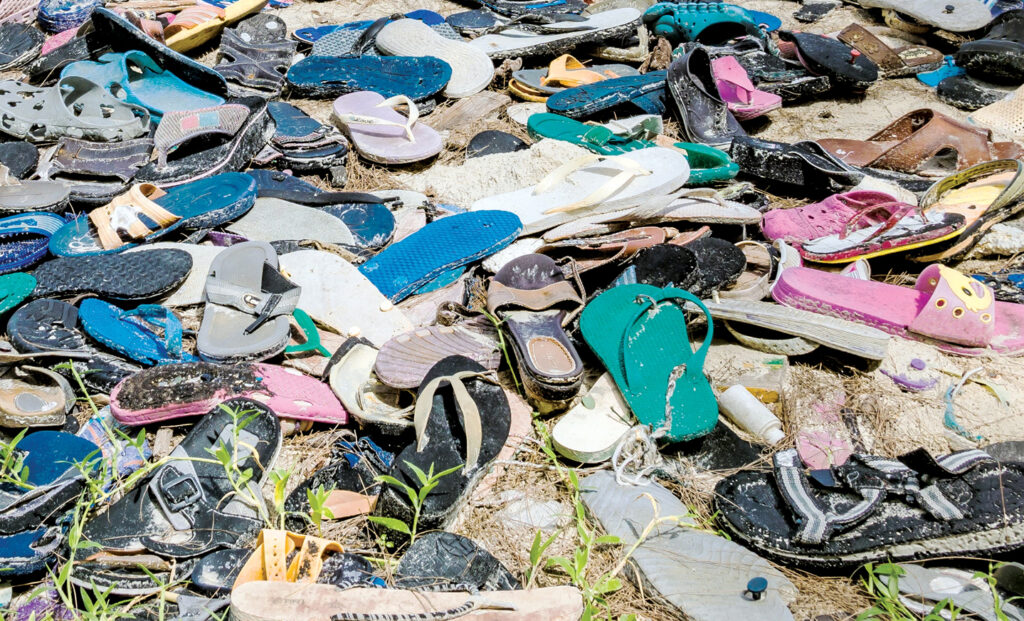
When Nike launched its Flyknit sneaker in 2012, it kickstarted a new era in sustainable footwear. The one-piece uppers, knit on a flat machine, created 60% less waste than traditional construction. The transition to recycled polyester (rPET) yarns in 2016 added to the brand’s sustainability cred.
adidas followed quickly with its Primeknit styles and in 2015 introduced a partnership with Parley for the Oceans, intercepting plastic waste on beaches and coastlines and turning it into rPET for shoes and apparel.
A decade later, sustainable sneakers from premium brands are front and center, worn by celebrities, sneaker heads and cool kids everywhere. “Sustainable footwear is on the rise, due to the development of startups, engaged initiatives by premium companies, and permeation into footwear by sustainability players,” says a report by Future Market Insights.

The cool factor
There’s no question that consumers are increasingly aware of sustainability in their sneakers. VEJA, a French brand “made differently” in Brazil, and Allbirds, the first with transparent carbon accounting, have garnered high marks. Both are certified B Corporations.
On the VEJA project website, the company explains, “We decided to make sneakers because this product symbolizes our generation and our era. It’s also a product that crystallizes the major issues of globalization through its production, dissemination and usage.”
VEJA works with fair-trade-sourced, organic cotton from Brazil and Peru, natural Amazonian chrome-free leather, plant-based leather and latex-based foam. The focus is on partnerships with suppliers and employees, combining social projects and economic justice with ecological materials. According to the company, this means VEJA sneakers cost five times more to manufacture than big-brand sneakers. Eschewing advertising and marketing, the company focuses on sustainability, transparency and social responsibility, which has resonated with consumers.
Headquartered in San Francisco, Calif., Allbirds began as a direct-to-consumer brand. The company found success with simple, comfortable styles and natural materials such as merino wool, eucalyptus fiber and sugar cane SweetFoam™. Allbirds was the first fashion brand to label its products with their carbon footprints. After collaborating with adidas on a low-carbon performance shoe in 2020, the company developed the M0.0NSHOT, a shoe with a carbon footprint of 0.0 kg CO2e, achieved without relying on offsets.
The M0.0NSHOT uppers are made with New Zealand merino wool, and the shoe features the brand’s new, sugar cane-based SuperLight Foam, along with bioplastic eyelets made with products from Mango Materials. M0.0NSHOT was unveiled at the June Global Fashion Summit in Copenhagen, Denmark.
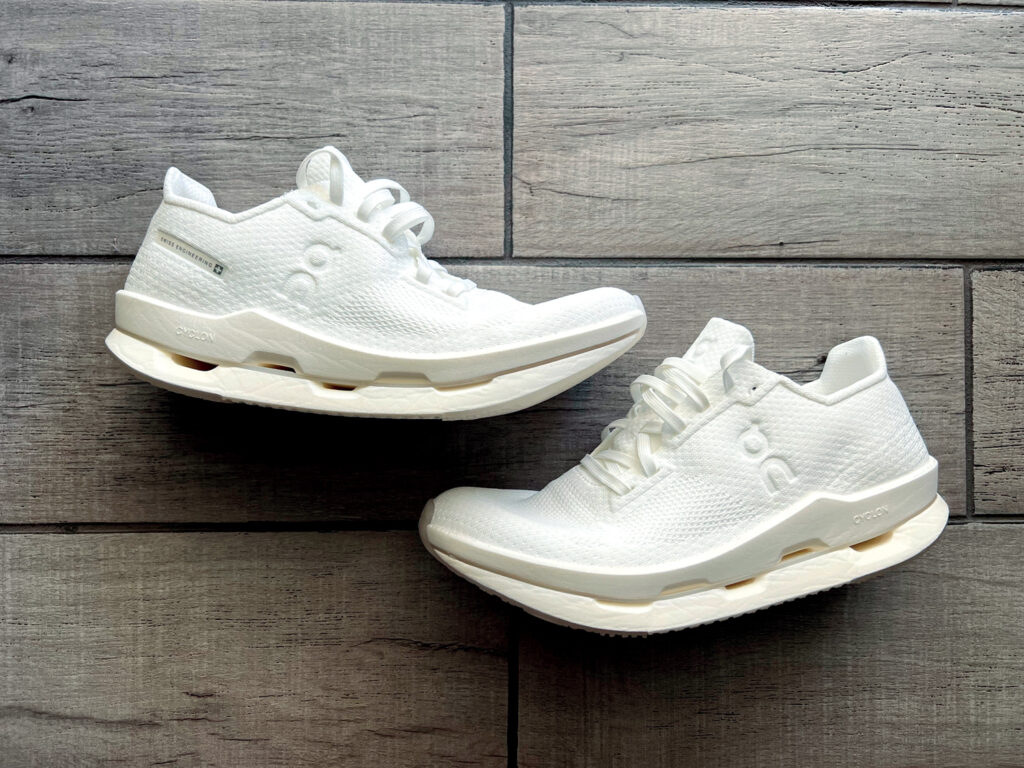
Keeping footwear out of landfills
The Future Market Insights report points out that footwear accounts for 20% of the apparel industry’s environmental impact, generating 700 million metric tons (more than 770 million U.S. tons) of CO2 as an annual byproduct of production and raw materials. According to a survey published by footwear brand Vivobarefoot, an estimated 22 billion pairs of shoes end up in landfills each year, taking an average of 30 to 40 years to decompose.
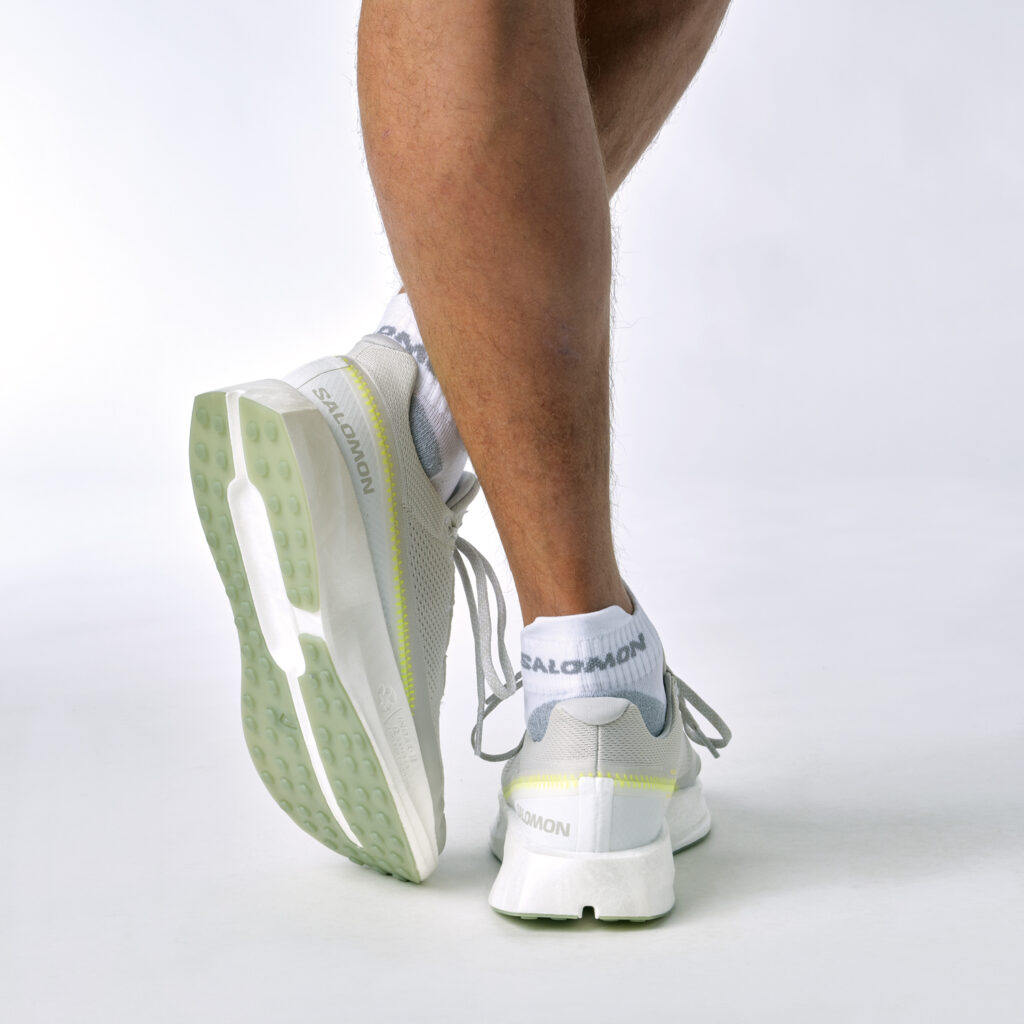
Footwear brands are jumping into takeback, repair and recycling programs to keep footwear out of landfills and designing circularity into their products from the outset. For example:
• On Running’s circular Cyclon™ subscription program is built around the Swiss company’s Cloudneo shoe, made from castor beans. The shoe is designed to last about six months, then returned to the company to be ground down and recycled. Subscribers are then sent a new pair.
• Salomon’s Index 02 running shoe is designed to be easily disassembled, with a nontoxic, nitrogen-infused thermoplastic polyurethane (TPU) midsole foam. A QR code registers the shoe, allowing the consumer to return it to Salomon for recycling. Salomon disassembles the shoes and reuses the materials in its Alpine ski boots.
• Thousand Fell’s sneakers are made from recyclable materials such as sugar cane, coconut husks, castor beans, aloe vera, recycled rubber, and rPET and can be returned for recycling through SuperCircle, which provides credit toward the next Thousand Fell purchase.
• Newcomer Zerofly™ has been launched on Kickstarter by Berlin, Germany-based Winqs Sports. The running shoe is composed of bio-based and recycled materials, including rPET, eucalyptus fiber, algae, castor beans and Michelin hybrid rubber. The shoes are intended to be sent back to partner Sneaker Rescue to be repaired or recycled. The remaining carbon footprint is offset through NGO myclimate.
• VEJA has opened sites in Bordeaux and Paris, France, and Berlin, where it will repair and recycle its sneaker. The brand also sells samples and dead stock.
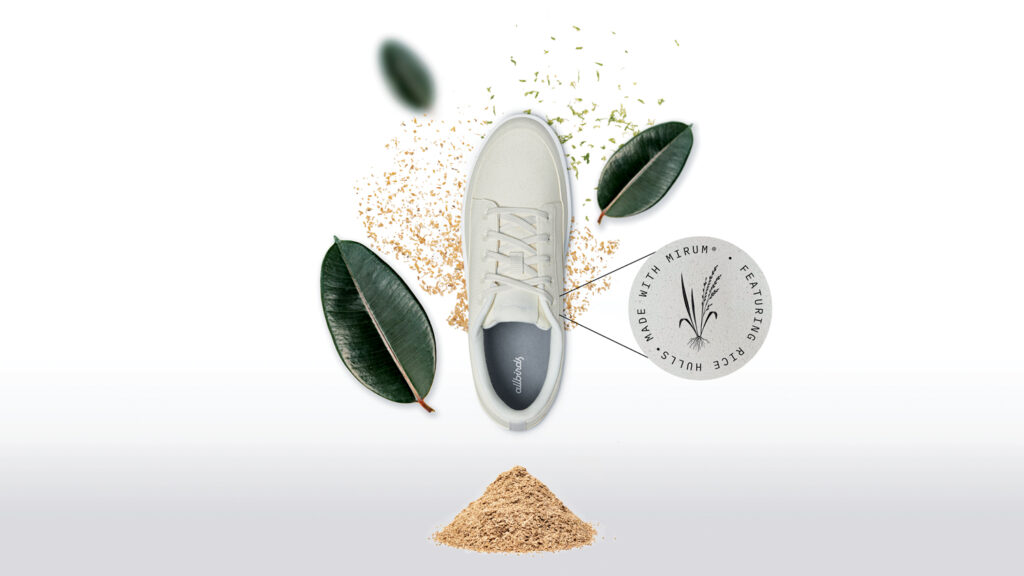
Purposeful design, sustainable materials
With performance and durability front and center, footwear manufacturers have historically used an unrecoverable mashup of materials, including a number of fossil fuel-based synthetic fibers, foams and glues that can take 1,000 years to break down. Searching for sustainable alternatives, labs at ingredient brands are busy brewing plant-based and nontoxic materials in collaboration with footwear brands and manufacturers.
Allbirds invested $2 million in Natural Fiber Welding (NFW) early in 2021 and in 2022 introduced its Plant Pacer sneaker made with MIRUM® plant leather. NFW also partners with sustainable brands Stella McCartney, Reformation and Pangaia.
A familiar name in the footwear industry, OrthoLite® is the world’s leading supplier of open cell foam technology found in more than 600 million shoes across all categories each year. In 2022 the Massachusetts-based company announced a sustainable midsole innovation called OrthoLite Cirql™, the first traditional plastic-free, recyclable, biodegradable and industrially compostable foam with an end-of-life solution.
Still in the trial stage, the product uses a biopolymer, created by Italian company Novamont, derived from non-GMO vegetable raw materials plus synthetic biodegradable materials. OrthoLite Cirql’s chemical-free foaming process uses nitrogen combined with renewable energy. The material can be returned to the production cycle by low-energy, advanced chemical recycling or be fully composted through industrial composting methods and processors.
Performance remains critically important, the company insists. “The reality is that most consumers will not sacrifice performance for sustainability. OrthoLite Cirql is third-party tested to validate our claims that this new innovation is a viable replacement to traditional plastic foams that use toxic or hazardous chemicals,” says chief sales officer CB Tuite.
“OrthoLite Cirql offers the solution of a plant-based biopolymer, chemical-free foaming, waste-free production, and fully biodegradable microplastics,” he adds. “Its two-part innovation, utilizing new materials and a patented, chemical-free foaming process, is what makes the end goal of circularity possible.”
Also well-established in the footwear industry is Arkema’s Pebax®, a family of thermoplastic elastomers found in high-performance footwear such as sports shoes and ski boots. The international chemical company’s U.S. base is in Pennsylvania. The company’s Pebax Rnew® is sustainably sourced from castor beans, which absorb CO2 from the atmosphere during the growth cycle.
The polymer is finding a home in sustainable footwear such as Mizuno’s Wave Rider 24 shoe, On Running’s Cloudneo Cyclon and the upcoming Winqs Zerofly.
Changing the footwear game
The global market for sustainable footwear is anticipated to grow at a compound annual growth rate of 6% in the next decade and reach a valuation of $17.18 billion, according to a Future Markets Insights report. Alan Lugo, product strategy manager of Natural Fiber Welding (NFW), views the current paradigm shift to sustainable footwear as “a perfect storm of consumer concern, government legislation, advocacy organizations and the work of material suppliers.”
OrthoLite’s Tuite agrees, “Consumers, brands and the factories that manufacture footwear have all been demanding change in order to reduce the pollution, the waste and the use of toxic chemicals in our footwear.”
Beyond sports shoes, casual and outdoor footwear brands are also sporting sustainability credentials. For the moment, however, sneakers rule the space.
Debra Cobb is a freelance writer with expertise in the textiles industry. She is based in North Carolina.
SIDEBAR: Nike’s ISPA pushes footwear innovation
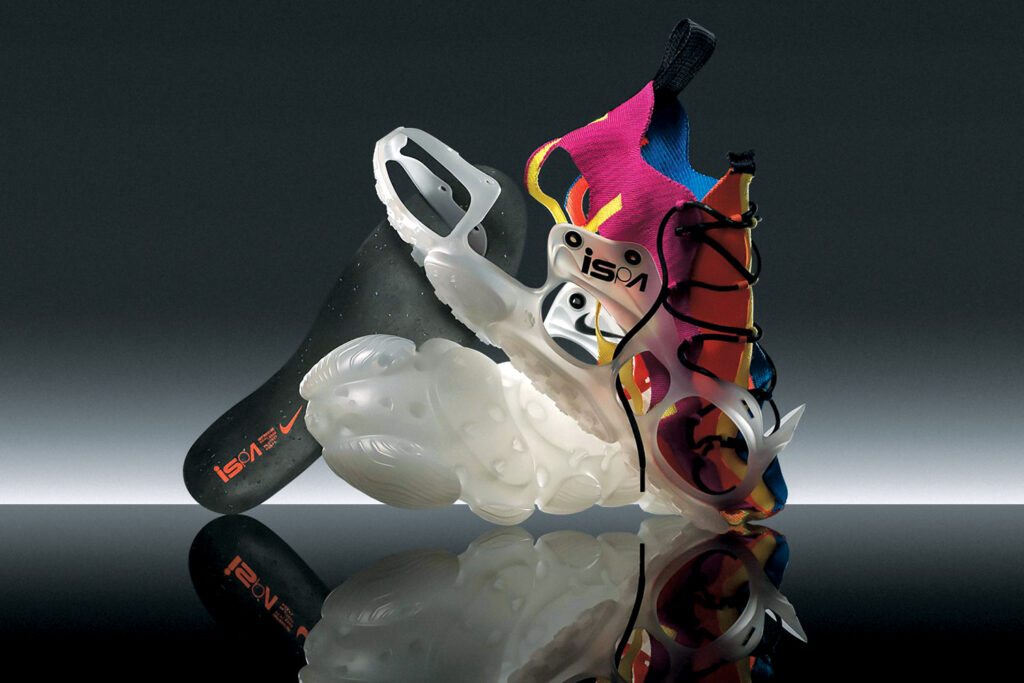
Nike’s ISPAnificio, an exhibition during Milan Design Week April 17–23, showcased the company’s ISPA shoe-making lab, taking giant steps when it comes to circularity. ISPA is a set of design principles—improvise, scavenge, protect, adapt—that breaks the mold of footwear design. The team designs shoes that can be taken apart and repurposed, utilizing sustainable materials such as Flyknit, algae inks, bio-based plastic foam and cork.
Shoes are built in modular pieces that snap together rather than using glues. Artificial intelligence (AI) enables wearers to incorporate replaceable parts or create their own molds. Everything can be disassembled, melted down and reused; nothing goes to waste.
“I feel like we need to collaborate more with each other. I think you see that a lot when you have these brands that are working together and trying to find better solutions. We all have different expertise, so let’s figure this out together,” Shamees Aden, senior footwear designer at ISPA, told Designboom. Photo: Nike
SIDEBAR: Can additive manufacturing make footwear more sustainable?
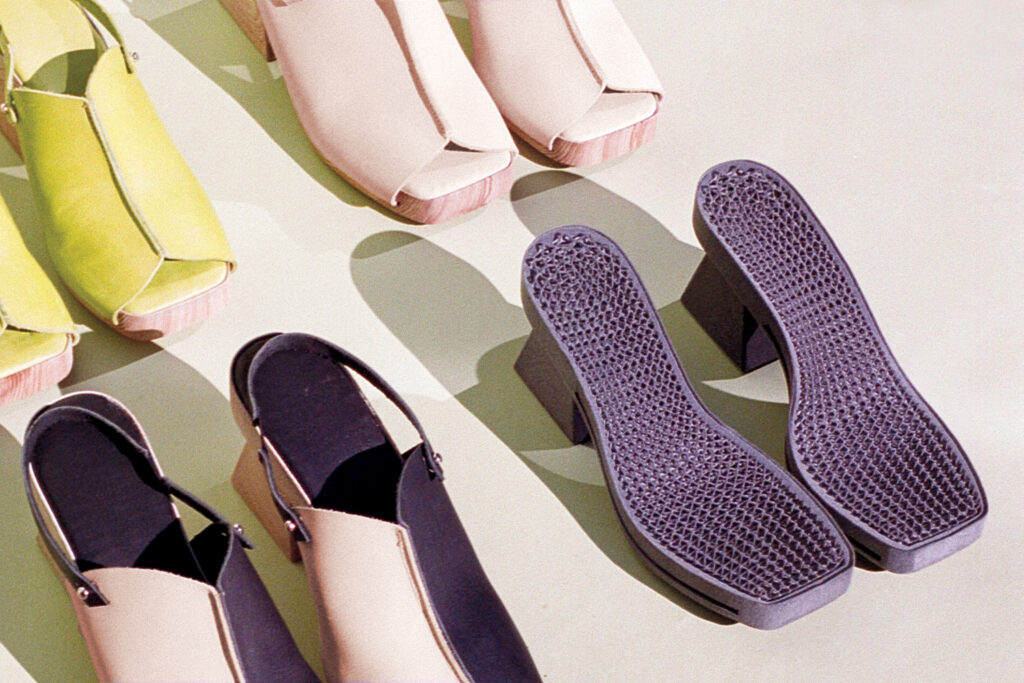
3D printing, or additive manufacturing, can reduce the greenhouse gas emissions of footwear manufacturing by some 48% and reduce water consumption by 99% compared with traditional footwear manufacturing, according to a study led by Portland, Oregon’s HILOS in partnership with Yale’s Center for Business and Environment.
HILOS’ circular product platform enables footwear brands to launch 3D-printed lines without inventory or waste. They also offer their own concept-design mules, clogs and sandals made out of thermoplastic polyurethane (TPU) in partnership with 3D printer GKN Additive. Their process not only cuts down on glue but also reduces the number of steps (and hence labor costs) in manufacturing and makes the shoes easier to disassemble for recycling at their end of life.
CEO and Co-Founder Elias Stahl says, “Today’s revolution in materials, 3D printing and AI-driven design provide a historic opportunity to reinvent global supply chains for an on-demand, zero-waste future. Instead of being an industry built around where to make, we can become one focused on how to make, so shoes can be made anywhere, locally and sustainably.”
HILOS recently raised $5 million in a funding round, with investment from Eric Sprunk, the former COO of Nike, alongside other Nike executives.
adidas’ work with Carbon, a Silicon Valley-based tech company, on its FUTURECRAFT line of 3D printed shoes, is also moving the sustainability needle. adidas’ newest FUTURECRAFT 4DFWD running shoes features Carbon’s new partially bio-based resin, EPU44, 40% derived from plants.
Carbon’s Digital Light Synthesis technology polymerizes the printed resin using light, creating lattice-like structures perfect for the soles of running shoes and other sports equipment.
 TEXTILES.ORG
TEXTILES.ORG


